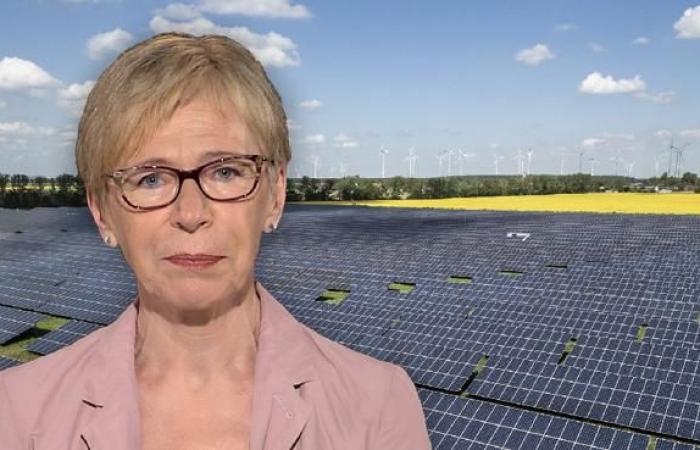
To combat global warming, it is imperative to reduce consumption and increase production from renewable sources. For Italy it is also the way to pay cheaper bills. According to the study ofInstitute for Energy Economics and Financial Analysis (IEFA) Italy is the largest producer of gas-fired electricity in the European Union with a production equal to that of Germany and Spain combined. The share of gas use in electricity production mix in 2023 it is approximately 45%Almost three times the EU average. Consequently, the price of electricity is linked to the price of gas. For this reason the energy paid for by our businesses and families it is much more expensive than that of the main European partners (report by Confindustria). The average price paid by Italian companies in April it reached 86.8 euros per megawatt hour (MWh), vs 62.3 euros from the Germany28.2 of France And 13.6 from the Spain.
Renewable sources and the growth of photovoltaics
The latest Integrated National Plan for Energy and Climate (Pniec) sent to the European Commission predicts that by 2030 we have to cover the 65% of electricity needs with renewable energy (here page 79). Today we are at 36.8%against the 52% of Spain, the 50% of Germany and the 27% of France which however produces most of its electricity with nuclear power. Among the renewable sources, the one that is growing the most in our country is photovoltaic. According to Italia Solare, an association representing 1,300 operators, they are connected 1.68 million implants and the lead regions are Lombardy, Veneto and Emilia-Romagna. 2023 was a record year: 373,929 plants installed for a power of 5.2 gigawatts more than the previous year. Effect of the incentives linked to the superbonus and of a very simplified regulation (art.9 decree law 17-2022) which facilitates the authorization process.
Residential and ground-mounted photovoltaic
However, 94% of the systems are residential or smallmounted mainly on roofs of houses and have a power less than 20 kW. The systems placed directly on the soil they do not require structural reinforcement work or architectural modifications e guarantee greater energy efficiency. Among these there are large ones designed to generate energy on a large scale: «The cost of a megawatt hour produced by ground-mounted photovoltaics is one third compared to residential ones – he explains to Dataroom the businessman Carlo Maria Magniat the head of the company ReFeel which creates solar systems -. On average 60 dollars against i 200 necessary for the energy generated on the roofs by small-sized systems (here page 5). Among the renewable sources, these plants are the most competitive ever: cheaper even than coal (average $68-166 per megawatt hour), nuclear ($141-222) and gas turbine power plants ($115-221)”.
They do not enjoy any incentives, yet in the first three months of 2024 the power generated by large plants increased by 373% thanks to the connection of 8 structures for a total of 281 Megawatts.
However, the road to obtaining authorizations is long and tortuous: the approval process must pass through an environmental, landscape and urban planning check. What complicates things and makes them uncertain is often the overlap of national regulations with regional ones. At the end of March there were 3,642 connection requests, a gigantic number compared to the projects that will actually be implemented.
The Agriculture and Suitable Areas decrees
Since these systems take up enormous spaces and cannot be installed everywhere, EU Directive 2018/2001/EU, transposed into Italian law in 2021, invites Member States to identify suitable surfaces and areas. After years of waiting, an agreement was reached in June ministries of Environment, Culture and Agriculture and the Unified State-Regions Conferenceand now the implementing decree «Suitable Areas» gives to the regions 180 days to identify the territories where the structures will be installed. Problem: in May the decree (Agriculture decree) stopped new ground-mounted photovoltaic systems on all agricultural land. With the exception of those financed by the Pnrr and those planned in areas such as quarries, mines, railway and airport concessions, areas adjacent to motorways and industrial sites. It is not yet clear whether the projects in the advanced authorization phase are safe or must be confirmed by the regions. The Agriculture decree, due to be converted into law in July, is in the Industry Committee of the Senate: more than 100 amendments to the art. 5 on the stop to installations on agricultural land.
The clash between Coldiretti and renewable energy entrepreneurs
And here the clash that has been going on for at least ten years between Coldiretti and renewables entrepreneurs is rekindled. The former rejoiced because the decree puts a stop to the “wild photovoltaics” of the energy multinationals, which occupy entire productive agricultural areas by promoting the consumption of land which “burns 1 billion of food every year”. Second Stephen Masini, head of the Environment of the farmers’ association, «we need to safeguard Italian food sovereignty, a unique exception in the world, from the invasion of panels which is now widespread across the entire peninsula, from North to South». They range from 142 hectares of photovoltaic park in municipality of Canaro in the province of Rovigo, at Viterbese where “almost half of the agricultural surface used is occupied by panels” up to Sicily which Coldiretti dubs “the island of mirrors” because due to the panels “thousands of hectares are now unproductive”.
On the other hand, the entrepreneurs of renewables, a sector that employs almost 150 thousand workersthey reply that with the rule, approximately 60 billion euros of investments will be lost. This can be read on the website of Solar Italy: «In Italy there are 16.5 million agricultural hectares – of which 4.2 million are uncultivated and abandoned». The precise data is provided by Ispra (Here page 45): in total the hectares occupied by photovoltaic systems reach 17,830 hectares, Meaning what 0.1% of all agricultural land. The association wrote an open letter to the Prime Minister Giorgia Meloni asking for the abolition of article 5 of the Agriculture decree because it not only «generates higher bills for citizens» but also limits «the freedom of farmers to be able to dispose of their property”. Several environmental associations including the WWF also rejected the measure: «It is an unjustified brake on development – we read in a press release – and nullifies all the planning and regulatory rationalization policies for renewable sources in recent years».
Agrivoltaics: a real prospect?
The decree gives an alternative: agrivoltaics. It means “advanced” systems that simultaneously involve the use of land for cultivation and for the production of photovoltaic energy. In practice the panels are at least suspended 1.3 meters from the ground in the case of livestock activity, e 2.1 meters in the case of crops. The problem is that compared to ground-based systems they cost from 30 to 60% more and are more vulnerable to extreme events. The Pnrr allocates 1.1 billion in non-repayable contributions to advanced agrivoltaics, to be assigned by June 30, 2026. An investment that allows you to install structures for maximum production of 1.04 Gigawatts.
Plants and agriculture
Summing up: the systems installed in Italy generate a power of 32.4 Gigawatts. Within 6 years we must reach the 80 Gigawattsapproximately 8.3 GW per year (here page 45). Mission impossible without the construction of new ground facilitiesbecause being more efficient they produce low-cost energy. And it is unrealistic to think that their power can be compensated with that obtained from the residential photovoltaicperhaps covering all Italian buildings with solar panels.
The certain fact is that agriculture, which we want to protect, remains the sector most penalized by climate change. Only in the last two years drought and floods have caused at least 12 billion in damages (here and here) and there loss of fertility on thousands of hectares of cultivated land.





